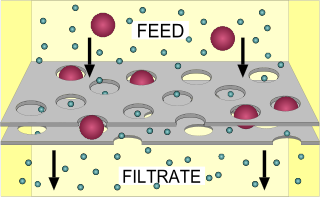
Filtration is a physical separation process that separates solid matter and fluid from a mixture using a filter medium that has a complex structure through which only the fluid can pass. Solid particles that cannot pass through the filter medium are described as oversize and the fluid that passes through is called the filtrate. Oversize particles may form a filter cake on top of the filter and may also block the filter lattice, preventing the fluid phase from crossing the filter, known as blinding. The size of the largest particles that can successfully pass through a filter is called the effective pore size of that filter. The separation of solid and fluid is imperfect; solids will be contaminated with some fluid and filtrate will contain fine particles. Filtration occurs both in nature and in engineered systems; there are biological, geological, and industrial forms.

Bird ringing (UK) or bird banding (US) is the attachment of a small, individually numbered metal or plastic tag to the leg or wing of a wild bird to enable individual identification. This helps in keeping track of the movements of the bird and its life history. It is common to take measurements and examine conditions of feather molt, subcutaneous fat, age indications and sex during capture for ringing. The subsequent recapture or recovery of the bird can provide information on migration, longevity, mortality, population, territoriality, feeding behavior, and other aspects that are studied by ornithologists. Other methods of marking birds may also be used to allow for field based identification that does not require capture.

Gillnetting is a fishing method that uses gillnets: vertical panels of netting that hang from a line with regularly spaced floaters that hold the line on the surface of the water. The floats are sometimes called "corks" and the line with corks is generally referred to as a "cork line." The line along the bottom of the panels is generally weighted. Traditionally this line has been weighted with lead and may be referred to as "lead line." A gillnet is normally set in a straight line. Gillnets can be characterized by mesh size, as well as colour and type of filament from which they are made. Fish may be caught by gillnets in three ways:
- Wedged – held by the mesh around the body.
- Gilled – held by mesh slipping behind the opercula.
- Tangled – held by teeth, spines, maxillaries, or other protrusions without the body penetrating the mesh.
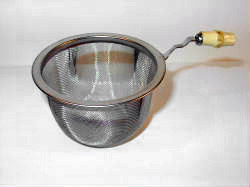
A mesh is a barrier made of connected strands of metal, fiber, or other flexible or ductile materials. A mesh is similar to a web or a net in that it has many attached or woven strands.

Mist nets are used by hunters and poachers, but also by ornithologists and bat biologists to capture wild birds and bats for banding or other research projects. Mist nets are typically made of nylon or polyester mesh suspended between two poles, resembling a volleyball net. When properly deployed in the correct habitat, the nets are virtually invisible. Mist nets have shelves created by horizontally strung lines that create a loose, baggy pocket. When a bird or bat hits the net, it falls into this pocket, where it becomes tangled.

A lobster trap or lobster pot is a portable trap that traps lobsters or crayfish and is used in lobster fishing. In Scotland, the word creel is used to refer to a device used to catch lobsters and other crustaceans. A lobster trap can hold several lobsters. Lobster traps can be constructed of wire and wood, or metal and netting or rigid plastic. An opening permits the lobster to enter a tunnel of netting or other one-way device. Pots are sometimes constructed in two parts, called the "chamber" or "kitchen", where there is bait, and exits into the "parlour", which prevents escape. Lobster pots are usually dropped to the sea floor, one or more at a time, sometimes up to 40 or more, and are marked by a buoy so they can be picked up later.
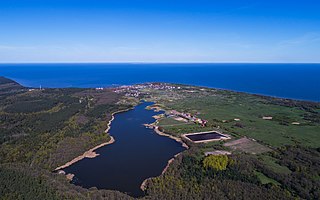
Rybachy, before 1946 known as Rossitten in East Prussia, is a rural settlement in Zelenogradsky District of Kaliningrad Oblast, Russia, located on the Curonian Spit. It was formerly known for the Rossitten Bird Observatory and the Rossitten gliding school.

Rocket nets and cannon nets are types of animal traps used to trap many live animals, usually birds, but they also have been used to catch large animals such as various species of deer. Rocket nets, cannon nets, and other net launching devices are built upon similar principles have been used since the 1950s.
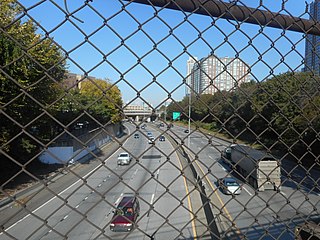
A chain-link fence is a type of woven fence usually made from galvanized or LLDPE-coated steel wire. The wires run vertically and are bent into a zig-zag pattern so that each "zig" hooks with the wire immediately on one side and each "zag" with the wire immediately on the other. This forms the characteristic diamond pattern seen in this type of fence.

Bird control is the generic name for methods to eliminate or deter pest birds from landing, roosting and nesting.
Mechanical screening, often just called screening, is the practice of taking granulated ore material and separating it into multiple grades by particle size.

Net or netting is any textile in which the yarns are fused, looped or knotted at their intersections, resulting in a fabric with open spaces between the yarns. Net has many uses, and comes in different varieties. Depending on the type of yarn or filament that is used to make up the textile, its characteristics can vary from durable to not durable.
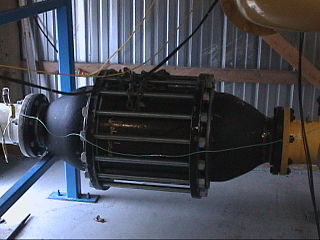
A flame arrester, deflagration arrester, or flame trap is a device that stops fuel combustion by extinguishing the flame.

Bird netting or anti-bird netting is a form of bird pest control. It is a net used to prevent birds from reaching certain areas.

A hand net, also called a scoop net, is a fishing net or meshed basket held open on a rigid hoop, which may or may not be mounted to the end of a handle. A hand net with a long handle is often called a dip net. When it is used by an angler to help fetch out ("land") a hooked fish, it is called a landing net.

The Heligoland Bird Observatory, one of the world's first ornithological observatories, is operated by the Ornithologische Arbeitsgemeinschaft Helgoland e.V., a non-profit organization which was founded in 1891 to support research on the fauna of Heligoland, a small German archipelago, comprising the islands of Heligoland and Düne, in the Heligoland Bight of the North Sea. The principal research focus is on bird migration through banding studies. Over 400 species have been recorded. OAG Helgoland produces an annual bird report.
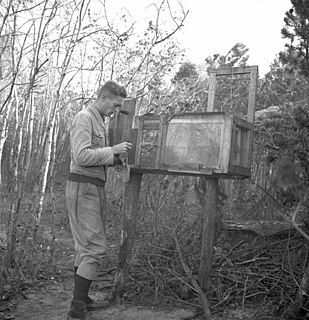
The Rossitten Bird Observatory was the world's first ornithological observatory. It was sited at Rossitten, East Prussia, on the Curonian Spit on the south-eastern coast of the Baltic Sea. It was established by German ornithologist Johannes Thienemann and operated until 1944. In 1945 East Prussia was divided between Poland, Russia and Lithuania, and most ethnic Germans expelled.

Bird trapping techniques to capture wild birds include a wide range of techniques that have their origins in the hunting of birds for food. While hunting for food does not require birds to be caught alive, some trapping techniques capture birds without harming them and are of use in ornithology research. Wild birds may also be trapped for their display in captivity in zoological gardens or for keeping as a pet. Bird trapping was formerly unregulated, but to protect bird populations most countries have specific laws and regulations.
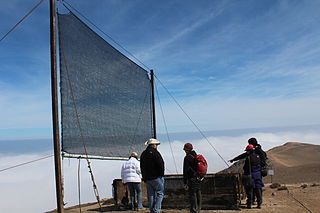
Fog collection refers to the collection of water from fog using large pieces of vertical mesh net to make the fog-droplets flow down towards a trough below, known as a fog fence, fog collector or fog net. Through condensation, atmospheric water vapour from the air condenses on cold surfaces into droplets of liquid water known as dew. The phenomenon is most observable on thin, flat, exposed objects including plant leaves and blades of grass. As the exposed surface cools by radiating its heat to the sky, atmospheric moisture condenses at a rate greater than that of which it can evaporate, resulting in the formation of water droplets.
Horticulture Netting or Vegetable Support Net




















